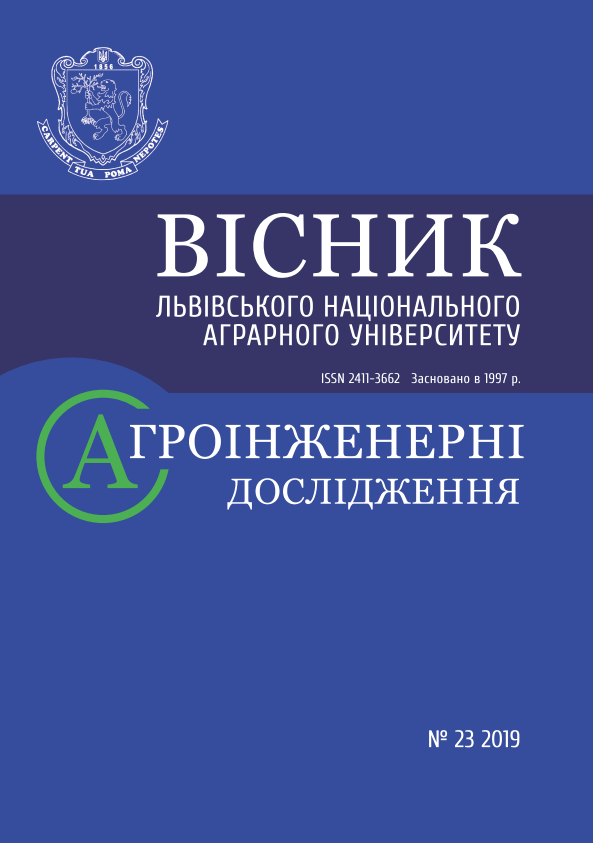OPTIMIZATION OF PULSE CONTROLLING OF ENGINE STOPPING
DOI:
https://doi.org/10.31734/agroengineering2019.23.095Keywords:
optimization, impulse control, DC motorAbstract
The research considers conditions of optimization of braking modes of the DC motor. While braking, the pulsation level of the braking current is minimized by the use of pulse width, frequency ulse and relay current regulation.
The optimal mode control supplies solution of the problems of energy efficiency and creates safe modes for DC traction motor control.
At present, traction electric motors with DC motors are used in electric transport. The field of application of direct current drive (DCD) motors with serial excitation motors (SEM) is wide enough and is the basis of rolling stock of urban and rail transport. The SEMs with exponentially decreasing mechanical characteristics are best for such mechanisms with nonlinear operating.
Efficiency of electric transport in general can be increased by replacement of the existing drive control system with more advanted ones, based on impulse control.
The introduction of additional elements in the scheme allows reducing of the rate of attenuation of the current in the brake coils.
Introduction of diodes in the circuit can provide a significant advantage of the proposed circuit modernization, which enables using of self-excitation of the electric motor for electrical braking.
The proposed solution simplifies technical implementation and reduces costs due to the absence of an additional independent power source of the brake coils.
Thus, optimization of the braking modes of DC motors, in particular by using pulse width modulation (PWM), is possible due to introduction of an intermediate energy storage device and an additional consumer. Safe modes of electric drive and power supply are realized and provided with crucial changes of parameters and conditions of the power supply network and electric drive.
References
Burlaka, V. V., Hulakov, S. V., & Podnebenna, S. K. (2019). Udoskonalennia skhemnykh rishennia chastotno-rehulovanoho elektropryvoda. Int. scientific and technical. conf. (Mariupol, May 16-17, 2019): in 4 volumes. (Vol. 1, pp. 247–248). Mariupol: State Technical University "PDTU".
Bruskin, D. Z., Zorokhovych, A. E., & Khvostov, V. S. (1990). Elektricheskie mashiny u mikromashiny. Moscow: Higher shk.
Vydmysh, A. A., & Troshyn, O. I. (2003). Teoriia elektropryvoda. Vinnytsia: UNIVERSUM.
Herman-Halkyn, S. H. (2002). Silovaia elektroniyka: Laboratornye raboty na PK. Sankt-Peterburg: Korona.
Herman-Halkyn, S. H., & Kardonov H. A. (2003). Elektricheskie mashiny: Laboratornye raboty na PK. Sankt-Peterburg: Korona.
Herman-Halkyn, S. H. (2001). Kompiuternoe modelirovanie poluprovodnikovykh system. Sankt-Peterburg: Korona.
Hlazenko, T. A. (1973). Poluprovodnikovye preobrazovateli v elektroprivodakh postoiannoho toka. Moskva: Energia.
Holts, M. E., Hudzenko, A. B., & Ostrerov, V. M. (1986). Bystrodeistvuiushchie elektroprivody postoiannoho toka s shirotno-impulsnymi preobrazovateliami. Moskva: Energoatomizdat.
Andrienko, P. D., Kapliyenko, A. O., Shilo, S. Y., & Nemudryi, Y. Yu. (2007). Issledovanie rezhiymov tormozhenia v sisteme impulsnoho rehulirovania seriesnoho elektrodvihatelia. Electrical Engineering and Power Engineering. 11–14.
Metelskyi, V. P. (2005). Elektrychni mashyny ta mikromashyny. Zaporizhzhia: ZNTU.
Mokin, B. I., Mokin, V. B., & Mokin, O. B. (2010). Matematychni metody identyfikatsii dynamichnykh system. Vinnytsia: VNTU.
Pehov, D. V., Burtsev, P. V., Andreev, V. E. (2003). Rukovodstvo po ustroistvu elektropoezdov ЭT2, ЭR2T, ЭD2T, ЭT2M. Moskva: Tsentr kommercheskikh razrabotok.
Perlmuter, V. M., Sydorenko, V. A. (1988). Sistemy upravlenyia tiristornymi elektroprivodamy postoiannoho toka. Moskva: Energoizdat.
Balan N. M., Iskendersad Sh. G., & Strelkovskaia I. V. (2002). Sposib halmuvannia dvyhuna postiinoho strumu ta prystrii dlia yoho realizatsii: pat. 47111A, MKI N02 RZ/08; Opubl.17.06.02, Biul. № 6. [in Ukrainian].
Aspalli, M., Asha, R., & Hunagund, P. (2012). Three phase induction motor drive using IGBTs and constant V/F method. International Journal of Advanced Research in Electrical, Electronics and Instrumentation Engineering, 1, 463–469.
Behera, P. K., Behera, M. K., & Sahoo, A. K. (2014). Speed Control of Induction Motor using Scalar Control Technique. International Journal of Computer Application, 1, 37–39.
Bondar, R. P., Golenkov, G. M., Lytvun, A. Y., & Podoltsev, A. D. (2013) Modelling of power characteristics of the vibrator with a linear electric drive. Electromechanical and energy saving systems, 2, 66–74.
Bondar, R. P., & Podoltsev, A. D. (2017). Complex model with frequency dependent parameters for electrodynamic shaker characteristics. Technical electrodynamics, 1, 44–51.
Choi, J. Y., & Kan, H. B. (2014). Comparison and dynamic behavior of moving-coil linear oscillatory actuator with/without mechanical spring driven by rectangular voltage source. Journal of International Conference on Electrical Machines and Systems, 3, 394–397.
Orlovskii, I. A. (2013). On the power in an electrical circuit with a valve. Works of the Tavria State Agrotechnological University, 13, 141–150.


